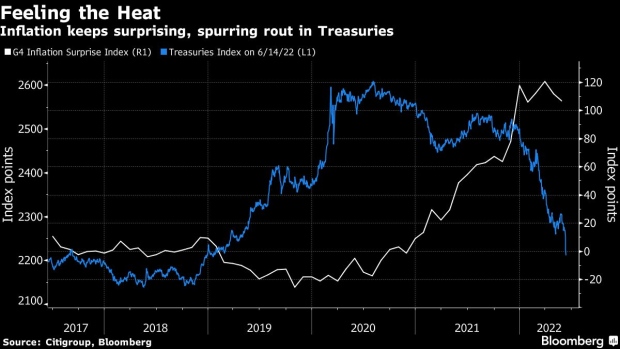Jun 15, 2022
Treasury Yields Eye 4% Mark as Inflation Complacency Shatters
, Bloomberg News

(Bloomberg) -- Treasury yields will head above 4% and investors face more turmoil because they continue to underestimate how strong and persistent inflation is going to be, said Stephen Miller, a three-decade bond market veteran.
“I’m surprised that so many people are so surprised -- many were raising concerns that central banks were laying the groundwork for inflation by continuing to pour stimulus into the economy long after it became apparent the pandemic’s economic impact had been overestimated,” said Miller, an investment consultant at GSFM, a unit of Canada’s CI Financial Corp.
“Now that CPI rates took off, investors are continually underestimating how sticky inflation has become.”
Treasuries crashed to the steepest selloff since 1987 this week, after Friday’s US CPI report showed inflation accelerated to a 40-year high. That stunned those who’d started to hope cost pressures were peaking. Swaps are pricing in above 80% odds the Federal Reserve will raise its target rate by three-quarters of a point, the biggest hike since 1994, when it meets later on Wednesday.
Miller said he expects the Fed will raise borrowing costs by that amount and could even go a full percentage point. Markets may react positively in the short term at least to whatever the Fed does provided Chair Jerome Powell makes it clear the aim is raise the cash rate fast enough to slow inflation.
The longer-term outlook for bonds will remain grim, as 10-year yields need to go above 4% at minimum, given they remain near historic lows when adjusted for inflation, he said. The benchmark bond yielded around 3.42% as of 10:35 a.m. in Tokyo.
“If Powell frames a move of 75 or 100 as part of a process of getting to neutral expeditiously, I think markets may draw some comfort if the narrative becomes one of a ‘short sharp shock’ rather than a elongated series of debilitating rate hikes,” Miller said. “The storm that the Fed is set to create in the coming months will be more severe if they prove to be too cautious in reining in inflation than if they are more aggressive in trying to get ahead of the game.”
Miller, who spent 14 years at BlackRock Inc.’s Australian unit managing fixed income, said he sees much in the setup for bonds that’s reminiscent of the 1970s. In particular, central banks have fallen well behind the curve on inflation and, even as they strive to catch up, investors and economists are finding it difficult to adapt to a world where cost pressures have surged out of control. Back then inflation was only tamed after then-Fed Chair Paul Volcker raised rates to 20%, including several hikes of 2 percentage points and more.
“Apart from the last 6 months or so we last saw trailing real yields at these levels in the mid-70s, when market expectations of inflation and how quickly inflation might be suppressed were also too optimistic,” he said. “I think we’re at a similar juncture where the market is perhaps underplaying how high yields need to go before they are in restrictive territory. For that reason I also think that Fed Funds may need to go above 4% to be appropriately restrictive.”
©2022 Bloomberg L.P.






